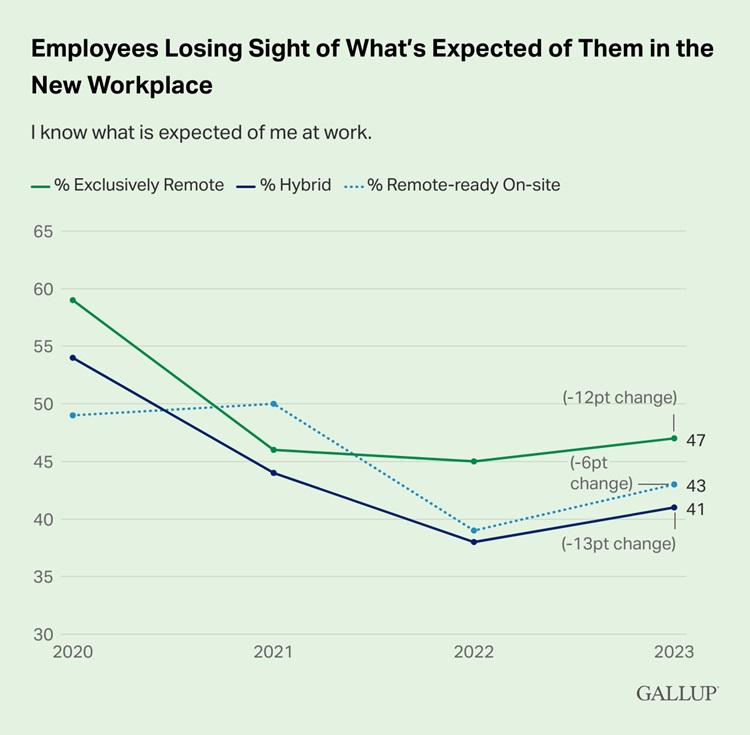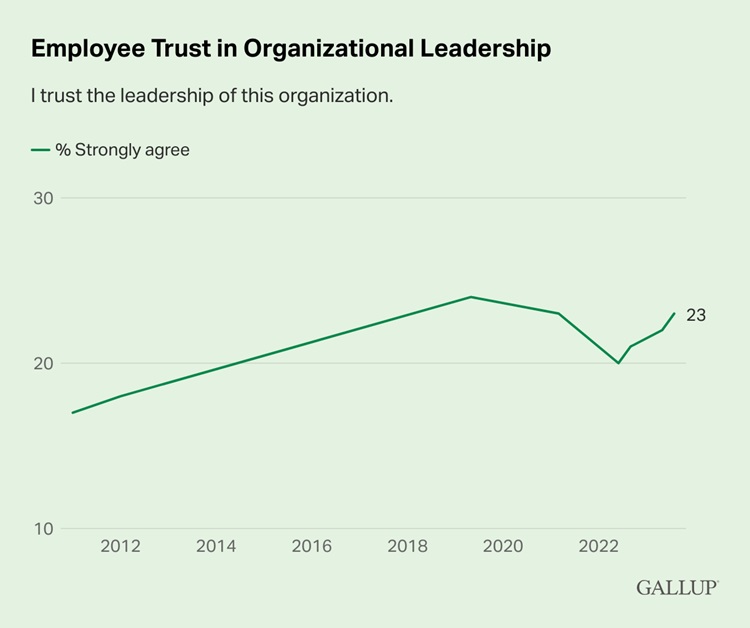Discover why employee engagement is crucial for business success – plus how to create a work environment that fosters motivation, productivity, and a happy workforce!
In today’s competitive business landscape, employee engagement is no longer a buzzword; it’s the cornerstone of a thriving workplace. Engaged employees are the backbone of a company’s success, driving positive customer experiences, fostering a collaborative environment, and contributing to the organization’s bottom line. But how do you create a work environment that fosters this kind of dedication and enthusiasm?
|
Author: Jonathan M. Pham |
Highlights
- Employee engagement is the level of enthusiasm and commitment an employee has toward their work and company. A higher level of engagement translates into higher productivity, innovation, and loyalty – which then results in reduced turnover, boosted performance, strengthened employer branding, and a culture of innovation and adaptability.
- Employee engagement can be seen as both an overall level of commitment (actively engaged, not engaged, disengaged) and a combination of mental focus (cognitive), emotional attachment, and physical effort. It is driven by several factors – including meaningful work, supportive leadership, growth opportunities, recognition, work-life balance, open communication, a safe work environment, and individual autonomy.
- Despite the benefits of employee engagement, many companies struggle. Strategies like clear communication, meaningful work, recognition, work-life balance, a positive culture, and continuous improvement may help them tackle the issue.
- While HR provides resources, it is leaders and direct supervisors who have the biggest impact on employee experience and engagement.
What is Employee Engagement?
Employee engagement refers to the level of enthusiasm, dedication, and commitment an employee feels towards their job and the organization they work for. It goes beyond just satisfaction; engaged employees are genuinely invested in the company’s success, demonstrate a sense of ownership over their work, and feel that their efforts do make a difference.
Imagine a salesperson who consistently exceeds their targets and helps onboard new colleagues. They might stay late to close a deal – or come up with creative solutions to improve customer service. This person is likely to feel engaged in their work and passionate about the company’s mission.
Common indicators of employee engagement:
- Understanding of role: Knowing what one’s job entails and being eager to fulfill their responsibilities.
- Loyalty and productivity: Loyal to their employer and motivated to work toward the success of the organization.
- Innovation: The ability to come up with new ideas and solutions.
- Emotional connection: Focused on working toward their organization’s goals.
- etc.
While HR departments play a key role in developing and implementing strategies to boost employee engagement, it’s ultimately a shared responsibility among numerous parties:
- Leaders: Setting the tone for the company culture, fostering open communication, and providing growth opportunities.
- HR: Designing programs that support employee well-being, learning & development, and recognition.
- Managers: Directly impacting their team’s engagement by providing clear goals, offering feedback, and creating a supportive environment.
- Employees: Taking ownership of their work, actively participating in company initiatives, and striving to improve their skills and contributions.
Characteristics of Employee Engagement
Engagement is about the level of investment one has in their work. Engaged employees are all-in, putting in discretionary effort and going above and beyond. On the other hand, disengaged team members are emotionally detached and simply fulfilling their basic job requirements.
Below is a detailed breakdown:
| Aspect | Engaged employees |
Disengaged employees
|
| Motivation | Enthusiastic and motivated |
Low morale and unenthusiastic
|
| Productivity | Highly productive |
Minimal effort, poor quality work
|
| Initiative | Proactive, take initiative |
Lack of initiative, wait for instructions
|
| Teamwork | Team players, collaborate effectively |
Negative and withdrawn, isolate themselves
|
| Problem-solving | Solution-oriented, identify problems and seek solutions |
Resistant to change
|
| Learning | Always learning, take advantage of development opportunities |
Limited interest in learning
|
| Work attitude | Positive, reliable, punctual |
High absenteeism, lack of punctuality
|
| Loyalty | Feel a sense of belonging and commitment to company goals |
High turnover risk
|
Employee Engagement vs Satisfaction, Happiness & Well-being
“Employee engagement” is often used interchangeably with other terms such as satisfaction, happiness, and well-being; however, there are key distinctions between them.
| Aspect | Engagement | Satisfaction | Happiness | Well-being |
| Focus | Enthusiasm, dedication, commitment to job & organization | Contentment with job aspects (pay, benefits, etc.); have their basic needs fulfilled | General emotional state (feeling good about work & life) |
Holistic state of physical, mental & emotional health
|
| Feeling | Invested in company success, motivated to go beyond job requirements | Happy with overall work experience, but may not necessarily be willing to exceed expectations | Content, optimistic, fulfilled |
Balanced, able to function effectively
|
| Action | Proactive, takes initiative, strives for excellence | Fulfills job duties adequately | May/may not improve work |
May/may improve work performance indirectly
|
| Example | Takes initiative, offers solutions, strives for excellence | Appreciates benefits, enjoys the work environment | Finds work meaningful, enjoys a work-life balance |
Has access to healthcare, feels supported, manages stress
|
| Relationship to work performance | Directly linked and improves performance | May or may not be directly linked | May or may not be directly linked |
Indirectly impacts performance (increased energy & focus)
|
| Scale | A broader concept that goes beyond satisfaction and happiness | More specific – with a strong focus on contentment with job aspects | Overall emotional state |
Focus on promoting holistic health – which indirectly impacts work
|
While distinct, these concepts are interconnected. High employee engagement often involves satisfaction, happiness, and well-being. Conversely, companies that prioritize employee well-being and satisfaction are more likely to notice an increase in terms of engagement.
Here’s an analogy: Think of engagement as actively steering a ship toward a destination (company goals). Satisfaction is being comfortable on the ship (happy with the work environment). Happiness is enjoying the journey (overall well-being). All are important, but engagement is what propels the ship forward.
The Importance of Employee Engagement in the Workplace
If you’re running a business, whether it’s a corner store or a multi-product multinational, there are three key indicators that really work: employee engagement, customer satisfaction, and cash flow.
Jack Welch
Employee engagement is a critical factor for building up a successful and thriving workplace. It produces a ripple effect that not only benefits individuals – but also strengthens HR practices and drives organizational development.
Human Resource Management (HRM)
- Reduced turnover
Engaged employees feel valued and invested in the company’s success – as well as a sense of purpose and accomplishment in what they do. As such, they’re more likely to see a future for themselves within the organization and feel less inclined to look for opportunities elsewhere.
- Cost savings
Recruitment and onboarding are expensive processes. Indeed, research by the Society for Human Resource Management (SHRM) has revealed that replacing an employee can cost up to one-third of their annual salary. This includes advertising, interviewing, training, and lost productivity during the vacancy period. Even if they do not leave, disengaged employees may cost companies billions due to lost productivity.
- Improved performance
On the other hand, engaged team members are more focused, motivated, and receptive to feedback – which leads to better outcomes and fewer resources wasted on correcting mistakes. In another study by SHRM, high employee engagement may translate to a 70% improvement in terms of output, and a 34% increase in the number of highly satisfied customers.
According to Gallup, when people are invested in a business’s objectives, the organization may expect to see a 2x-5x success rate (calculated based on a combination of metrics such as turnover, retention, finance, customer satisfaction, etc.), as well as a rise of 23% in terms of profits.
- Enhanced talent acquisition & employer branding
Engaged employees are more likely to recommend their employer to others, participate in industry events, attend career fairs on behalf of the company, or even use social media to share their positive work experiences. This results in an organic and authentic channel to attract top talent – and form a pool of pre-qualified candidates who are already familiar with the organization’s culture and work environment.
- A healthier workforce
Feeling a sense of control and purpose in one’s work is the precedent to reduced stress and anxiety, which are major contributors to health problems. When individuals have a more positive outlook at work, they are more likely to adopt healthier lifestyle choices, such as exercising more, eating healthier foods, and getting enough sleep. In addition, they become more focused and present at work – which means a potential decrease in the likelihood of getting distracted or making mistakes that could lead to safety accidents.
Organizational Development (OD)
- Promoting innovation & decision-making
When people feel empowered and valued, they are more inclined to take risks, share unconventional ideas without fear of ridicule, and collaborate with others to brainstorm/ bring innovative solutions to life. This diversity in terms of input allows for a more holistic view of business situations – and ensures that all decisions are well-informed and lead to positive outcomes.
Example:
A marketing team is planning a new advertising campaign. Disengaged employees might simply follow the usual routine. However, an engaged team member from the social media department might suggest incorporating a user-generated content element, while a salesperson proposes targeting a new customer segment. These diverse perspectives can lead to a more creative and effective campaign that reaches a wider audience.
- Enhanced agility & adaptability
Engaged employees are open to change – they understand that the business landscape is constantly evolving, and are willing to embrace new processes, technologies, or strategies. As such, they might proactively seek opportunities to develop new skills and knowledge, so as to adapt to changing demands. When faced with uncertain situations, these people are better equipped to remain calm and work with others to devise solutions.
Read more: Agility Coaching – Navigating Change & Fueling Business Success
- Stronger workplace culture
Imagine a tech startup with a highly engaged workforce. Employees from different departments readily share ideas during brainstorming sessions. Senior developers mentor junior programmers, and marketing specialists collaborate with the sales team to develop targeted outreach campaigns. This open communication, mutual support, and willingness to share knowledge create a strong and positive company culture that fuels innovation.
To win in the marketplace you must first win in the workplace.
Doug Conant

Read more: Talent Management – Strategies for Organizational Success
Types of Employee Engagement
Generally speaking, there are two main ways to categorize employee engagement:
Levels of engagement
This approach is based on one’s overall commitment and enthusiasm towards their work and the organization.
- Actively engaged: These are your ideal employees. They are passionate, dedicated, and go above and beyond their job duties. They are highly productive, innovative, and contribute significantly to the company’s success.
- Not engaged: These people are essentially just going through the motions. They meet expectations but lack motivation/ initiative – and are unlikely to propose new ideas or put in extra effort.
- Actively disengaged: These are your most problematic employees. They are unhappy, unproductive, and may even spread negativity to others. As such, they are at high risk of leaving the company or causing disruptions.
Dimensions of engagement
For this framework, the focus is on the three core aspects:
- Cognitive engagement: This refers to one’s mental connection to their work. Specifically, they understand their role, the company’s goals, and how their work contributes to the bigger picture – while feeling a sense of purpose and meaning in what they do.
- Emotional engagement: Emotional attachment is measured by how one feels passionate about their work, believes in the company’s values, and demonstrates a sense of belonging.
- Physical engagement: This involves the level of energy and effort one puts into their work. They are physically present, focused, and able to perform their duties efficiently.
Employee Engagement Cycle – Main Stages
When it comes to the employee engagement cycle, there are different models with varying numbers of stages. That said, a common structure typically is made up of these key phases:
- Attraction: This stage focuses on attracting top talent to the organization. It involves employer branding, creating compelling job descriptions, and utilizing effective recruitment strategies.
- Onboarding: Once selected, the new hires need to go through an onboarding process to be ready for success. In this stage, they are provided with the information, resources, and support they need to integrate smoothly into their role and the company culture.
- Development: Everyone has a natural desire to learn and grow. This phase involves offering opportunities for professional development through training programs, coaching, mentorship, and employee skill-building initiatives.
- Recognition & reward: Feeling valued and appreciated is a significant motivator. In the next step, organizations typically proceed to implement programs that acknowledge and reward employee contributions, achievements, and milestones.
- Retention: The goal is to keep your best talent engaged and prevent them from leaving for other opportunities. This stage focuses on building up a positive work environment, offering competitive compensation and benefits, and fostering career growth opportunities.
- Re-evaluation: Employee engagement is not a one-time achievement. Organizations need to regularly measure engagement levels through surveys, feedback sessions, and one-on-one meetings. This helps identify areas for improvement and adapt your people development strategy accordingly.
Additional notes:
- Some frameworks might include an “Offboarding” stage to ensure a smooth transition when employees leave the organization.
- The specific activities and approaches within each stage will vary depending on your organization’s culture, size, and industry.

Key Drivers of Employee Engagement
Engagement comes from within the employee. It’s the emotional connection or commitment that an employee has to the organization that then causes the employee to want to put forth the additional effort to ensure the organization and the brand succeed.
Annette Franz
Over time, research has identified several components that contribute to a strong employee engagement culture – some of which include:
- Meaningful work: Employees crave a sense of purpose in their work. They want to feel their contributions matter and that their work aligns with the company’s mission and values.
- Supportive management: Trustworthy and transparent leadership that sets a clear vision, provides regular feedback, and empowers team members.
- Trust in leadership: Employees need to trust that their leaders are guiding the team in the right direction.
- Opportunities for professional development: These include access to training programs, mentorship opportunities, and clear career paths.
- Recognition and appreciation: While competitive salaries are important, money isn’t the only motivator. Recognition taps into the desire to feel like a valued member of the team, contributing to a purpose. In fact, a study by McKinsey has revealed that public recognition of achievements, rewards for outstanding work, and a culture of appreciation go a long way and can contribute to a whopping 55% of employee engagement.
- Work-life balance: Offering flexible work arrangements, respecting personal time, and promoting well-being initiatives all contribute to engagement.
- Open communication: A two-way communication flow characterized by employees feeling comfortable expressing ideas, concerns, and feedback – and leaders who actively listen and are transparent in sharing information.
- Positive, psychologically safe work environment: A safe, respectful, and collaborative work environment in which everyone feels safe to take risks, experiment, and make mistakes without fear of retribution.
- Autonomy and ownership: Team members are empowered to make decisions and take ownership of their work.
- Alignment with core values: Those who share the company’s values and mission are more likely to be engaged and committed to the job.
Emotional commitment comes when employees find personal meaning from the work they do. Meaning need not be grandiose, and is inherently personal.
Dave Ulrich
Challenges of Fostering Employee Engagement
According to research by Gallup, up to 80% of employees worldwide are not engaged in their work. Disengagement is a critical factor that gives rise to a plethora of issues like burnout. Despite the various benefits mentioned above, many organizations still fail in their efforts to foster engagement, which leaves us with one question: Why?
Here are some of the common hurdles companies often face:
Lack of clear communication
A big disconnect between leadership and employees – characterized by unclear goals, information silos, and a lack of transparency – can lead to confusion, discouragement, and ultimately, disengagement, as employees feel like they’re not on the same page as the management and aren’t sure what exactly is expected of them.
For example, imagine a company launching a new marketing campaign. The leaders might say they want to “increase brand awareness,” but that’s a vague target. Employees on the ground need specifics. Do they aim to double website traffic? Or gain a certain number of followers on social media? Without clear goals, employees might waste time on activities that don’t contribute to the overall objective – and ultimately feel checked out and have little reason to put in extra effort.

Employee engagement statistics
(Source: Gallup)
Absence of meaningful work
Imagine a data entry job where an employee spends all day simply typing numbers from one system to another. There’s minimal variation, no challenge, and little room for creativity. While this type of work might be necessary, it often gives rise to feelings of boredom and a lack of stimulation.
When employees don’t find their work inherently interesting or purposeful, they’re less likely to go the extra mile/ take initiative – and might just do the bare minimum to get by. In the long run, a lack of meaningful work will drive them to leave their jobs in search of more engaging opportunities.
Employees don’t automatically become engaged when you give them more praise, thanks, or any other type of acknowledgment. But, employees can quickly become disengaged if they feel like they’re invisible.
Mike Kappel
Unsupportive leadership
Micromanaging, failure to recognize contributions, poor feedback practices, etc. all drain the enthusiasm out of even the most dedicated individuals. At the same time, if the management is not committed to promoting workplace engagement, even the most well-planned initiatives are doomed to fail.
Limited growth opportunities
Without access to training or new projects, employees won’t be able to develop their skillsets – which not only results in demotivation but also makes them less valuable in the long run. If one cannot foresee that their efforts lead to future advancement, they will become more likely to deem their work pointless and start looking for opportunities elsewhere.
Poor work-life balance
Poor work-life balance is a major culprit behind employee disengagement. When work consistently bleeds into personal time, employees become physically and emotionally exhausted, leading to decreased productivity and increased health problems. In addition, it also causes friction with family, friends, and personal commitments. Feeling like work dominates life is what causes many to feel unappreciated and less invested in their jobs.
Unhealthy work environment
A toxic work environment characterized by bullying, harassment, or a lack of respect poses a devastating impact on engagement. If team members feel disrespected or bullied, the result will be decreased morale, increased anxiety/ stress, reduced trust, and high turnover rates.
Lack of customization
A one-size-fits-all approach to employee engagement is a recipe for failure. It’s because different generations/ employee groups come with different priorities and motivators.
Imagine a marketing team at a large corporation. The team consists of experienced baby boomers nearing retirement, energetic millennials seeking growth opportunities, and a few Gen Z employees just starting their careers.
- Baby Boomers: They may value job security, stability, and recognition for their experience. A well-structured career path and opportunities to mentor younger colleagues could be highly motivating for them.
- Millennials: Millenials often crave purpose, professional development, and a sense of belonging. Providing opportunities for learning new skills, participation in collaborative projects, and a strong company culture could be more engaging for them.
- Gen Z: They might prioritize work-life balance, flexible work arrangements, and social impact initiatives. Offering remote work options, compressed workweeks, and volunteer opportunities could be more effective in engaging them.
Technological challenges
The rise of remote and hybrid work models presents new challenges for fostering engagement. Remote team members are likely to feel isolated and miss the casual interactions that occur in the office. There’s a lack of team spirit and a sense of “us vs. them” between remote and in-office team members – which often leads to miscommunication, reduced collaboration, loneliness, and decreased productivity.
How to Improve Employee Engagement: Strategies that Work
Here are some effective strategies that HR and leadership can implement to improve employee engagement:
Communication & transparency
- Clearly communicate the company’s vision, mission, and values – so that employees see how their work contributes to the bigger picture.
- Hold regular town halls, Q&A sessions, and team meetings to foster open communication and address concerns.
- Encourage two-way communication through suggestion boxes, surveys, and anonymous feedback channels.
- Practice transparency by sharing relevant information about company decisions and performance.
Meaningful work & growth
- Assign tasks that are challenging but achievable – so as to foster a sense of accomplishment.
- Offer opportunities for professional development through training programs, conferences, and mentorship opportunities.
- Empower employees to make decisions and take ownership of their work.
- Help employees see the impact of their work by showcasing success stories and celebrating achievements.
- Outline clear career paths (including the skills and experience required for advancement) and provide guidance for advancement within the company.
Recognition & appreciation
- Implement a recognition program to acknowledge and reward employee contributions publicly and privately.
- Offer bonuses, incentives, or rewards that go beyond compensation (etc. additional paid time off) to recognize high performers.
- Provide regular feedback, focusing on both strengths and areas for improvement, delivered constructively and in a timely manner.
- Celebrate milestones and achievements, both big and small, to show employees their hard work is valued.
Work-life balance & well-being
- Offer flexible work arrangements such as remote work options, compressed workweeks, or flexible start and end times.
- Promote healthy work-life balance by discouraging working long hours or checking work emails outside of work hours.
- Discourage after-hours messages/ calls unless they are absolutely necessary.
- Provide access to wellness programs such as gym memberships, stress management workshops, or Employee Assistance Programs (EAPs).
- Encourage breaks and time off to prevent burnout and help team members recharge.
Positive work environment & culture
- Build up a culture of trust and respect where employees feel safe to express themselves and take risks.
- Foster a workplace that values different backgrounds, perspectives, and experiences.
- Promote teamwork and collaboration by creating opportunities for employees to work together on projects.
- Organize social events and team-building activities to foster camaraderie and a sense of community.
- Implement a zero-tolerance policy for bullying or harassment to ensure a safe and inclusive work environment.
- Encourage leadership to set the tone for the organization – by demonstrating behaviors that foster engagement like open communication, appreciation, and a commitment to employee well-being.
- Provide training for managers and leaders to develop their skills in engaging and motivating their teams.
Tailoring the approach
- Recognize that different generations and employee groups may have varying needs and preferences – and conduct surveys or focus groups to understand your workforce better.
- Tailor your engagement strategies to address these diverse needs for maximum impact.
Continuous improvement
- Regularly measure employee engagement through surveys, stay interviews, and exit interviews.
- Use data and feedback to identify areas for improvement in your approach over time.
Read more: High-performance Culture – A Blueprint for Driving Excellence

Best Practices for Employee Engagement
- Set a clear vision
As mentioned, a well-defined vision paints a picture of the company’s ultimate goal – which gives team members a sense of purpose, as if they’re contributing to something larger than just their daily tasks. When employees connect with the company’s core values and principles, they are more likely to feel a sense of alignment and purpose in their work.
An employee is far more likely to be engaged when they have clear performance expectations, the tools to do their job well and a manager who cares about them as a person (rather than just an ‘economic unit of production’) and communicates effectively with them.
Ross Clennett
- Move beyond personality-based decisions
It is a tendency for managers and organizations to hire only people with positive, proactive, conscientious, and outgoing personalities. While they may be more likely to be engaged in their work, personality should not be the sole deciding factor.
Some people, while perhaps not naturally “enthusiastic,” are critical thinkers – they come with valuable work experience that contributes to breakthrough thinking, leading to a more dynamic and engaging work environment. As such, focusing solely on personality traits like “outgoing” may cause a lack of diversity in work experience and thought, ultimately harming innovation and problem-solving.
Expecting people to be engaged because the employer thinks they’re passionate types isn’t a long-term winner.
Todd Raphael
- Focus on skill development
By addressing skill gaps, both technical (hard skills) and interpersonal (soft skills), employees become more effective in their roles – which translates to increased productivity, better problem-solving, and improved collaboration. When it comes to skill training, it is recommended that organizations adopt a personalized approach and provide a variety of learning methods – to both demonstrate commitment to employee growth and keep them engaged throughout the process.
If you truly want to customize their experience, you have to work at it. Find out how they like to learn and then structure their opportunities to learn around that style.
Mike Haberman
Imagine a company that develops educational software. Through internal marketing, they share stories about how their software is making a difference in children’s education, organize “Impact Days” where employees volunteer at schools using their software, and feature employee achievements on the company intranet and social media platforms.
These efforts create an emotional connection for employees. They see the impact of their work, feel valued for their contributions, and become more passionate about the company’s mission. This translates to increased job satisfaction, a desire to stay longer, and a drive to contribute even more to the company’s success.
Someone who has found a true sense of meaning at work and has therefore bought into the dream, is far less likely to leave than one who is simply paid a lot. Put simply, organizations need to provide more than just a job.
Gary Browning
Leadership and Employee Engagement
Employees – especially the stars – join a company and then quit their manager. It may not be the manager’s fault so much as these managers have not been prepared to coach the new workforce.
Jim Clifton
Employee engagement isn’t solely an HR responsibility. While HR may be responsible for providing the framework, tools, and resources, direct supervisors and leaders are the ones who have the most significant day-to-day impact on employee experiences and attitudes. Indeed, Gallup research has demonstrated that leaders may make up a whopping 70% difference in terms of engagement. When employees lose confidence in the management, engagement goes down as a result – before later resulting in their decision to quit.

Employee trust in organizational leadership
(Source: Gallup)
Given the impact of leadership on workplace engagement, it has become imperative for organizations to conduct executive coaching sessions for those in senior positions. Coaching enables leaders to learn how to deliver timely constructive feedback, practice active listening, handle conflicts, delegate tasks, and inspire their team toward a common goal. As such, they become better equipped to identify and nurture employee talent, and provide opportunities for learning and development – which keeps employees motivated and engaged.
Good leaders are meaning makers who help each employee find his or her personal meaning through their work activities.
Dave Ulrich
Employee Engagement Ideas & Activities
- Team lunches: Organize informal lunch gatherings for teams or departments to connect outside of work-related tasks. Consider inviting guest speakers or conducting internal knowledge-sharing sessions on relevant topics during these breaks to further compound the effect.
- Mentorship programs: Pair experienced employees with newer ones to foster knowledge sharing and build relationships.
- Company outings: Plan social outings like bowling nights, happy hours, or team-building activities to encourage camaraderie.
- Bring Your Family to Work Day: Allow employees to bring their families for a designated day to showcase the work environment and foster a sense of community.
- Employee Spotlight: Showcase a different employee each week or month, highlighting their achievements and contributions.
- Milestone celebrations: Recognize and celebrate work anniversaries, birthdays, or personal achievements of employees.
- Gamification: Integrate game elements like points, badges, leaderboards, and challenges into everyday work to make it more fun and motivating.
- Internal hackathons: Encourage creative problem-solving and innovation by hosting internal hackathons or challenges with exciting themes.
- Book clubs/ discussion groups: Facilitate book clubs or discussion groups focused on professional development topics or industry trends.
- Wellness programs: Provide access to wellness programs like gym memberships, on-site fitness classes, or discounts on health and wellness services.
- Healthy snack options: Stock the office pantry with healthy snacks and beverages to promote well-being.
Read more: Employee Engagement Quotes – Inspire & Engage
Measuring Employee Engagement – Key Metrics & Indicators
Key metrics & indicators:
- Attitudinal measures:
- Employee surveys: Regular surveys with anonymous responses allow employees to express their opinions and feelings about various aspects of their work and the company culture. Questions might target topics such as job satisfaction, sense of purpose, alignment with company values, recognition and appreciation, work-life balance, or likelihood to recommend the company as a great place to work (eNPS – Employee Net Promoter Score).
- Exit interviews: Conducting in-depth interviews with departing employees can provide valuable insights into why they’re leaving and areas for improvement.
- Focus groups: Gathering a smaller group of employees for focused discussions allows for deeper exploration of specific topics related to engagement.
- Behavioral measures:
- Absenteeism and turnover rates: High absenteeism and turnover rates can indicate disengagement. Analyze trends and reasons behind these metrics.
- Performance reviews: Performance reviews can reveal changes in productivity, quality of work, and initiative-taking.
- Meeting attendance and participation: Active participation in meetings and discussions could indicate a higher level of engagement.
- Indirect measures:
- Customer satisfaction scores: Engaged employees are more likely to deliver positive customer experiences, potentially impacting customer satisfaction scores.
- Social media sentiment: Monitor online reviews and social media mentions to gauge employee sentiment about the company.
- Idea submission rates: High participation in internal suggestion programs or innovation challenges could indicate a more engaged workforce.
Tools for measuring employee engagement:
- Employee survey platforms: Online platforms simplify survey creation, distribution, and data analysis, offering insightful reports and employee sentiment tracking.
- People analytics tools: Advanced software can combine survey data with HR data (performance, absenteeism) to provide a more comprehensive picture.
- Pulse surveys: Short, frequent surveys can gauge employee sentiment on specific topics in real-time, allowing for quicker course correction as needed.
- Employee engagement apps: Mobile apps can provide employees with a convenient way to give feedback, participate in polls, and access company resources, potentially boosting engagement.
Read more: Enhancing Team Productivity with the Right Software

Employee Engagement Survey Template
Below is a template to provide a starting point for you to craft your own employee engagement survey. Make sure to tailor the questions to your specific company culture and priorities.
General Information (Optional)
- Department
- Tenure at company
Engagement
Strongly Agree | Agree | Neutral | Disagree | Strongly Disagree
- I feel that my work is meaningful and contributes to the company’s goals.
- I am satisfied with the opportunities for professional development offered by the company.
- I feel recognized and appreciated for my contributions.
- I have a good work-life balance.
- I am confident in the future of the company.
- I would recommend this company as a great place to work.
Open Ended Questions:
- What are the things you enjoy most about working at [Company Name]?
- What are some ways we can improve employee engagement at [Company Name]?
- Do you feel empowered to make decisions in your role? Why or why not?
- What are your biggest challenges or frustrations at work?
- Is there anything else you would like to share about your experience at [Company Name]?
When it comes to employee surveys, you need to first select a user-friendly online platform for easy access and data collection. Before sending it out to your entire workforce, it is recommended that you run a pilot test with a small group to identify and address any clarity issues.
To boost participation, promote the survey through company-wide communication channels. Consider offering a small incentive to further encourage responses (optional). Once the survey concludes, compile and analyze the data to identify trends and areas for improvement – before sharing the key findings with both your employees and leadership team.
Good vs. Poor Survey Questions
Here’s a comparison between good and poor survey questions to illustrate best practices:
Good question:
- I am satisfied with the opportunities for professional development offered by the company. (Multiple choice with clear answer options)
- Why are you satisfied/dissatisfied with the opportunities for professional development offered by the company? (Open ended – allows for elaboration)
Why it’s good:
- Clear and concise: Easy for employees to understand.
- Multiple Choice with Open Ended Follow-up: Provides flexibility for both specific responses and detailed feedback.
Poor Question:
- How is the professional development at the company? (Open-ended – lacks direction)
- Do you feel like you are growing in your role? (Leading question – assumes a positive response)
Why it’s poor:
- Vague: Doesn’t provide specific areas for feedback.
- Leading: Pushes employees towards a specific answer.
Beyond Employee Engagement
While employee engagement is crucial, it’s just one piece of the puzzle. In fact, over time, companies need to gradually switch their focus to something even grander – employee experience. Here’s why:
- Focus on feelings: Engagement primarily measures an employee’s emotional connection to their work. While important, it doesn’t necessarily translate to direct business outcomes.
- Limited scope: Engagement often focuses on specific aspects of work like workload or recognition. It might miss broader issues impacting the overall work experience.
- Passive approach: Engagement surveys can be a one-time snapshot. They don’t necessarily capture the ongoing journey employees have within the company.
Employee experience (EX) involves the entire journey an employee has with a company, from onboarding to offboarding. It considers all the touchpoints that influence how they feel, think, and behave at work. By focusing on EX, companies adopt a more holistic approach that fosters a more engaged, productive, and innovative workforce, ultimately achieving the “new possible” for both individuals and the whole organization.
The Future of Employee Engagement
The future of employee engagement is being shaped by several key trends, largely driven by evolving work models and employee expectations. Here’s a breakdown of what to watch out for:
- Remote and hybrid work: The rise of remote and hybrid work models necessitates new strategies to maintain connection, collaboration, and a sense of community among a geographically dispersed workforce.
- Focus on employee well-being: With the blurring of work-life boundaries in remote work, organizations will need to prioritize staff wellness by promoting healthy work habits, offering mental health resources, and fostering a culture of work-life balance.
- The multigenerational workforce: Managing a workforce with multiple generations, each with their own work styles and preferences, requires a more flexible and adaptable approach to engagement.
- Data-driven decisions: Leveraging people analytics and employee engagement data will be crucial for measuring the effectiveness of engagement initiatives and tailoring them to specific needs.
What organizations and leaders can do to prepare for the future:
- Develop a remote-friendly culture: Invest in collaboration tools, establish clear communication protocols, and promote virtual team-building activities to foster connection in a remote setting.
- Prioritize well-being: Offer flexible work arrangements, promote healthy boundaries between work and personal life, and provide access to mental health resources.
- Bridge the generational gap: Create a culture of inclusion where all voices are heard. Offer mentorship programs and training opportunities to bridge the knowledge gap between generations.
- Design a Positive EX: Map the employee journey and identify touchpoints where you can improve the experience (which encompasses all aspects of an individual’s work life). Gather feedback regularly and iterate on your EX strategy.
- Embrace a data-driven approach: Utilize surveys, pulse surveys, and people analytics to measure engagement and EX metrics. Use data to identify trends and target your efforts effectively.
- Invest in Learning & Development: Offer skill-building programs, tuition reimbursement, and opportunities for knowledge sharing to empower employees to grow professionally.
Improving Employee Engagement Starts With Developing Leadership
At ITD World, we understand the cornerstone of a thriving organization: its people. Engaged employees are more productive, innovative, and ultimately, happier. But fostering that engagement doesn’t happen by accident – it starts at the top, with strong leadership. That’s why we offer a comprehensive suite of coaching, leadership, and HR training solutions designed to:
- Develop essential leadership skills: Our programs hone communication, coaching, delegation, and conflict resolution skills, equipping leaders to effectively guide and motivate their teams.
- Craft a culture of engagement: We help leaders understand the drivers of engagement and create strategies to foster a work environment where employees feel valued, empowered, and passionate about their work.
- Bridge the generational gap: Our training equips leaders to navigate a multigenerational workforce, understanding different communication styles and preferences to maximize engagement across all age groups.
- Leverage data-driven insights: We show leaders how to utilize data from surveys and employee feedback to measure engagement and tailor their approach for continuous improvement.
Investing in leadership development is an investment in the future of your organization. When your leaders are equipped with the skills and knowledge to inspire and engage their teams, everyone wins!
Contact ITD World today to discuss your unique needs and explore how our customized leadership development solutions can help you build a team of highly engaged and productive employees!
Other resources you might be interested in:
- Fish Philosophy: Creating a Joyful & Productive Workplace
- Coaching Culture: Blueprint for Organizational Growth
- HR Business Partner (HRBP): Bridging HR & Business for Remarkable Results
- Succession Planning: Securing the Future of Business

